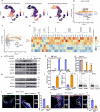Extracellular traps from activated vascular smooth muscle cells drive the progression of atherosclerosis
- PMID: 36473863
- PMCID: PMC9723654
- DOI: 10.1038/s41467-022-35330-1
Extracellular traps from activated vascular smooth muscle cells drive the progression of atherosclerosis
Abstract
Extracellular DNA traps (ETs) represent an immune response by which cells release essential materials like chromatin and granular proteins. Previous studies have demonstrated that the transdifferentiation of vascular smooth muscle cells (VSMCs) plays a crucial role in atherosclerosis. This study seeks to investigate the interaction between CD68+ VSMCs and the formation of ETs and highlight its function in atherosclerosis. Here we show that ETs are inhibited, and atherosclerotic plaque formation is alleviated in male Myh11CrePad4flox/flox mice undergoing an adeno-associated-virus-8 (AAV8) mediating overexpression of proprotein convertase subtilisin/kexin type 9 mutation (PCSK9) injection and being challenged with a high-fat diet. Obvious ETs generated from CD68+ VSMCs are inhibited by Cl-amidine and DNase I in vitro. By utilizing VSMCs-lineage tracing technology and single-cell RNA sequencing (scRNA-seq), we demonstrate that the ETs from CD68+ VSMCs influence the progress of atherosclerosis by regulating the direction of VSMCs' transdifferentiation through STING-SOCS1 or TLR4 signaling pathway.
© 2022. The Author(s).
Conflict of interest statement
The authors declare no competing interests.
Figures






Similar articles
-
SCAP knockdown in vascular smooth muscle cells alleviates atherosclerosis plaque formation via up-regulating autophagy in ApoE-/- mice.FASEB J. 2019 Mar;33(3):3437-3450. doi: 10.1096/fj.201800975RRR. Epub 2018 Nov 21. FASEB J. 2019. PMID: 30462530
-
PCSK9 (Proprotein Convertase Subtilisin/Kexin Type 9) Triggers Vascular Smooth Muscle Cell Senescence and Apoptosis: Implication of Its Direct Role in Degenerative Vascular Disease.Arterioscler Thromb Vasc Biol. 2022 Jan;42(1):67-86. doi: 10.1161/ATVBAHA.121.316902. Epub 2021 Nov 23. Arterioscler Thromb Vasc Biol. 2022. PMID: 34809446
-
Clock Gene Bmal1 Disruption in Vascular Smooth Muscle Cells Worsens Carotid Atherosclerotic Lesions.Arterioscler Thromb Vasc Biol. 2022 May;42(5):565-579. doi: 10.1161/ATVBAHA.121.316480. Epub 2022 Mar 3. Arterioscler Thromb Vasc Biol. 2022. PMID: 35236106
-
Effect of PCSK9 on Vascular Smooth Muscle Cell Functions: A New Player in Atherosclerosis.Curr Med Chem. 2021;28(36):7446-7460. doi: 10.2174/0929867328666210531150302. Curr Med Chem. 2021. PMID: 34060998 Review.
-
Lipid accumulation and novel insight into vascular smooth muscle cells in atherosclerosis.J Mol Med (Berl). 2021 Nov;99(11):1511-1526. doi: 10.1007/s00109-021-02109-8. Epub 2021 Aug 3. J Mol Med (Berl). 2021. PMID: 34345929 Review.
Cited by
-
Disturbed flow regulates protein disulfide isomerase A1 expression via microRNA-204.Front Physiol. 2024 Apr 4;15:1327794. doi: 10.3389/fphys.2024.1327794. eCollection 2024. Front Physiol. 2024. PMID: 38638277 Free PMC article.
-
Vascular Smooth Muscle Cells: A Therapeutic Target in Atherosclerosis.Rev Cardiovasc Med. 2025 Jun 26;26(6):28240. doi: 10.31083/RCM28240. eCollection 2025 Jun. Rev Cardiovasc Med. 2025. PMID: 40630429 Free PMC article. Review.
-
Lipid infiltration promotes trans-differentiation of vascular smooth muscle cells into macrophage-like cells in early lesions of human coronary atherosclerosis.Lipids Health Dis. 2025 Jul 14;24(1):239. doi: 10.1186/s12944-025-02662-y. Lipids Health Dis. 2025. PMID: 40660209 Free PMC article.
-
Multi-Omics Analysis Combined with Machine Learning Identified FABP4 in Smooth Muscle Cells as a Pathogenic Factor in Atherosclerosis.J Inflamm Res. 2025 Jul 26;18:10029-10049. doi: 10.2147/JIR.S519114. eCollection 2025. J Inflamm Res. 2025. PMID: 40740974 Free PMC article.
-
Neutrophil extracellular traps: a catalyst for atherosclerosis.Mol Cell Biochem. 2024 Dec;479(12):3213-3227. doi: 10.1007/s11010-024-04931-3. Epub 2024 Feb 24. Mol Cell Biochem. 2024. PMID: 38401035 Review.
References
Publication types
MeSH terms
Substances
LinkOut - more resources
Full Text Sources
Molecular Biology Databases
Research Materials
Miscellaneous

